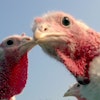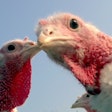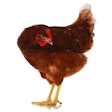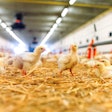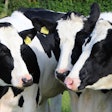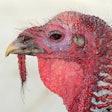A critical component of an experiment that proved evolution happens 15 times faster than was previously believed relied upon genetic lines of chickens from Virginia Tech. The discovery utilized the DNA of lines of White Plymouth Rock chickens that have been developed for more than 50 years.
The research was published recently in Biology Letters, a journal of Royal Society Publishing. The discovery involved researchers from several universities, including the University of York, Oxford University, the University of Sydney, Uppsala University, the Swedish University of Agricultural Sciences, and Virginia Tech.
“This experiment and many others involving everything from animal appetites to genetics could never have been done without the pedigree lines here at Virginia Tech,” said Paul Siegel*, distinguished professor emeritus of animal and poultry sciences in the College of Agriculture and Life Sciences. “This experiment was also an excellent example of international collaboration between six countries that was necessary for the success of the study.”
Siegel, along with Ben Dorshorst and Christa Honaker, also in the Virginia Tech Department of Animal and Poultry Sciences, were co-authors on the paper.
The pedigree lines of White Plymouth Rock chickens were developed by Siegel, who began breeding them in 1957. From the common founder population, he produced two distinct lines of chickens selected for high- and low-body weight. Today, the high-weight line dwarfs its low-growth counterpart by an average of 12 times more by the time they reach the eight-week selection age.
In the latest experiment, researchers analyzed blood samples of chickens of the same generation using the most distantly related maternal lines to reconstruct how the mitochondrial DNA passed from mothers to daughters. Mitochondria are specialized structures in the cells of animals, plants, and fungi that generate energy, synthesize proteins, and package proteins for transport to different parts of the cell and beyond.
“Previously, estimates put the rate of change in a mitochondrial genome at about 2 percent per million years,” said Greger Larson, professor of archaeology at Oxford University, in a news release. “At this pace we should not have been able to spot a single mutation in just 50 years, but in fact we spotted two.”
The sampling scheme yielded 385 mitochondrial transmissions that were analyzed for linkages within the mitochondrial DNA.The rate of evolution was calculated by analyzing the number of observed mutations in the approximately 16,000 samples of mitochondrial DNA in the genome over 47 generations.The scientists then reconstructed the maternal pedigree based on the mitogenome sequences.
“Our observations reveal that evolution is always moving quickly, but we tend not to see it because we typically measure it over longer time periods,” Larson continued. “Our study shows that evolution can move much faster in the short term than we had believed from fossil-based estimates.”
The experiment also determined that mitochondria are not solely passed down from maternal lines. Strictly maternal inheritance has long been thought of as the characteristic of mitochondrial genomes.
“The thing everyone knew about mitochondria is that it is almost exclusively passed down the maternal line, but we identified chicks who inherited their mitochondria from their father,” said Michelle Alexander, lead author. This finding supports the theory that “paternal leakage” is not such a rare phenomenon.
This is not the first time the scientific community has benefited from the research done on Virginia Tech’s high- and low-body weight chicken lines. A 2010 article in the scientific journal Nature was a breakthrough in genetic studies of animal domestication, thanks in part to these two lines.
*In 2010, the American Poultry Historical Society inducted Siegel into the American Poultry Association Hall of Fame, the industry’s top honor. In 2011, he was given an honorary doctorate from the Swedish University of Agricultural Sciences.

